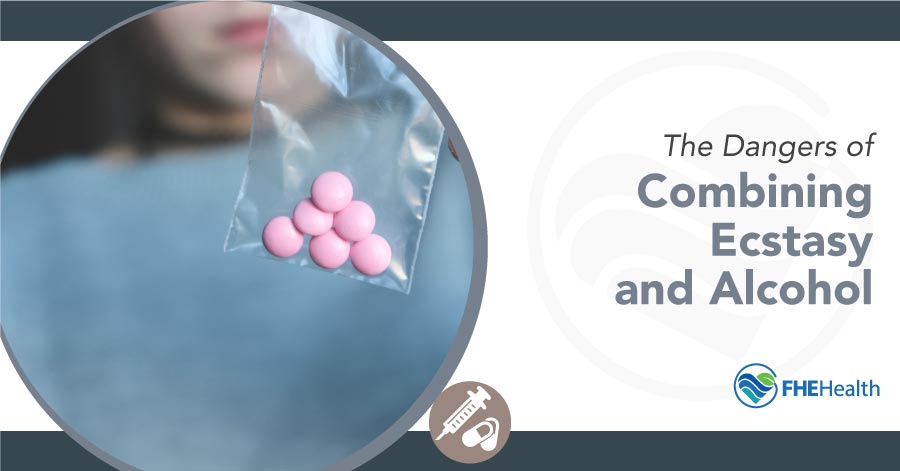
Alcohol is the most popular substance in America. It’s legal for those over 21, very easily accessible and part of recreation in many facets of popular culture. Around two thirds of adults drink alcohol, and over 5 percent engage in heavy drinking. It has a presence at most parties from young adulthood onward, making beer, wine and liquor hard to avoid.
The popularity of alcohol makes it a common choice for those who enjoy mixing substances, including combining drinking and ecstasy. However, blending drugs that can affect the brain may have dangerous ramifications, especially in high doses. The effects of molly and alcohol together can, unfortunately, be serious, putting users at risk of dehydration, hyponatremia, and brain chemistry changes, among other complications.
The Effects of Alcohol
Alcohol is a highly popular choice for those who like to relax alone or party with friends due to its intoxicating side effects. Increased alcohol intake causes feelings of relaxation, sociability, lowered inhibitions and increased recklessness. However, the sensations many drinkers enjoy don’t diminish the dangers of heavy use.
Alcohol is a central nervous system depressant. This means that drinking alcohol slows down brain function and suppresses forms of neural activity due to the impact on GABA, a neurotransmitter Even a drink or two can show measurable effects, like the slurred speech, clumsy movements, reduction in rational thought, and lowered inhibitions that are associated with drunkeness.
The more alcohol is consumed, the more significant these complications. And, when alcohol is consumed in excess, CNS depression can prove deadly, slowing brain functioning to a point that may cause coma, respiratory failure, or even death.
The Effects of Ecstasy
Ecstasy, often referred to as X, E, MDMA, or molly, is a common club drug. Unlike alcohol, which may be paired with a nice dinner or consumed in limited amounts to destress, ecstasy is rarely used outside of party settings. It comes in liquid and powder form, but is most often available in a tablet. Ecstasy has both hallucinogenic and stimulant effects—a big departure from alcohol’s depressant qualities.
Ecstasy is popular in clubs and at parties due to its primary side effects: heightened energy, increased sociability, intense sensory awareness and a perceived boost in empathy. However, some of the side effects accompanying these pleasant sensations can be less than enjoyable, including:
- Chills
- Sweating and increased body temperature
- Nausea
- Increased heart rate and hypertension
- Rapid breathing or panting
- Blurred vision
- Paranoia and anxiety
Mixing MDMA and Drinking
For those who party regularly, the opportunity to mix alcohol and other drugs will likely arise sooner or later. Alcohol takes a leading role at most clubs, raves, festivals and parties, and most people who enjoy these kinds of events are moderate drinkers at minimum—though there are always exceptions.
For some people, alcohol can make social gatherings more enjoyable, particularly for those who find pleasure in the recklessness and lowered inhibitions that can accompany a few drinks. Drugs like MDMA can be appealing in these circumstances, as well in those who like to take drugs. The heightened sensory awareness and increased sociability can add to the perceived fun of a night out, making use quite appealing.
For those who want more of a good thing and to enjoy the effects of both substances when used individually, combining alcohol and ecstasy may seem like a no-brainer. The combination can be very dangerous, however.
The Side Effects of Molly and Alcohol
Combining MDMA and alcohol is somewhat common among young adults in party settings, but this mixture can be deadly.
Ecstasy alone carries with it a high risk of dehydration due to the tendency for users to sweat profusely. This can be compounded when alcohol is in the picture, since alcohol is a diuretic. Between frequent urination and sweating, it’s possible for the body to lose a significant amount of water. By the time a user is thirsty and dizzy, dehydration has likely already set in.
The high likelihood of dehydration can lead to another complication: “hyponatremia.” Hyponatremia is a condition in which the concentration of sodium within the blood drops to an unsafe level. This most commonly occurs when drug and alcohol users try to remedy signs of serious dehydration and drink too much water too fast. This condition can cause headaches, confusion, fatigue and nausea—and may require medical intervention to properly treat. Without proper care, symptoms can escalate to seizures and unconsciousness.
In extreme cases, mixing ecstacy and alcohol can also lead to rhabdomyolysis. Most often seen in weightlifters or crossfit enthusiasts who attempt to push their muscles past the point of safe use, rhabdomyolysis, often referred to as rhabdo, can cause a breakdown of muscle in a way that releases muscle fibers into the blood. Serious cases of rhabdo can cause severe kidney damage or even prove fatal if not properly treated.
These are the most serious risks of mixing drinking and drugging, but there are other concerns to be noted. First, ecstasy can minimize the sedative effects of alcohol, causing users to feel more awake or alert than they truly are. This can lead to a decreased perception of intoxication and continued drinking past a safe level, increasing the possibility of alcohol poisoning. Conversely, alcohol may also prolong the effects of ecstasy past a desired point, leaving users feeling euphoric long after a party draws to an end.
As both ecstasy and alcohol can impact brain chemistry and heart function, taking both together on an ongoing basis can lead to challenging long-term consequences. This mix may put unsafe levels of stress on the heart and contribute to serotonin depletion in the brain.
Seeking Help for Substance Abuse
Mixing alcohol and MDMA may seem like a fun Saturday night in college, but combining substances can be an early warning sign of substance abuse. Desiring a high beyond what a single drug or drink can provide may indicate that usage habits are starting to spiral, and abusive behavior patterns are developing. When partying reaches this extreme level, getting help may be the best possible way to avoid lasting ramifications.
If you or someone you love is suffering from an addiction to drugs or alcohol, the right help can make all the difference. Contact FHE Health today to learn more about taking the first steps toward a life of sobriety.






